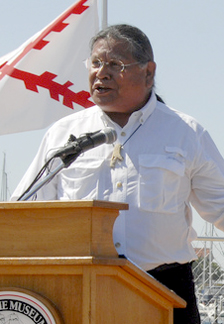
Kumeyaay
The Kumeyaay, also known as 'Iipai-Tiipai or by the historical Spanish name Diegueño, is a tribe of Indigenous peoples of the Americas who live at the northern border of Baja California in Mexico and the southern border of California in the United States. They are an indigenous people of California.
For other uses, see Kumeyaay (disambiguation).The Kumeyaay language belongs to the Yuman–Cochimí language family. The Kumeyaay consist of three related groups, the 'Iipai, Tiipai, and Kamia. The San Diego River loosely divided the 'Iipay and the Tiipai historical homelands, while the Kamia lived in the eastern desert areas. The 'Iipai lived to the north, from Escondido to Lake Henshaw, while the Tiipai lived to the south, in lands including the Laguna Mountains, Ensenada, and Tecate. The Kamia lived to the east in an area that included Mexicali and bordered the Salton Sea.
(Northern Digueño)
'Iipai
(Kamia)
Kumeyaay proper
(Southern Digueño) in northern Baja California
Tiipay
All languages and dialects spoken by the Kumeyaay belong to the Delta–California branch of the Yuman language family, to which several other linguistically distinct, but related, groups also belong (including the Cocopa, Quechan, Paipai, and Kiliwa). Native speakers contend that, within their territory, all Kumeyaay ('Iipay/Tiipay) can understand and speak to each other, if even after a brief familiarization.[4]
Nomenclature and tribal distinctions are not widely agreed upon. According to Margaret Langdon, who is credited with doing much of the early work on documenting the language,[5][6] the general scholarly consensus recognized three separate languages:
Katherine Luomala considered that the wide range of dialect variations reflected only two distinct languages, 'Iipai and Tiipai,[7] a view mostly supported by other researchers.[8][9]
Pawai (Poway)
Sinyweche (Santee)
Tecate
Tecuan (Tijuana)
Kumeyaay traditional narratives
Kumeyaay astronomy
at San Diego State University
Sycuan Institute on Tribal Gaming
Viejas Casino
; Rick, Torben C.; Jones, Terry L.; Porcasi, Judith F. (2010). "One If by Land, Two If by Sea: Who Were the First Californians?". In Jones, Terry L.; Klar, Kathryn A. (eds.). California Prehistory: Colonization, Culture and Complexity. Lanham, MD: AltaMira Press. pp. 53–62. ISBN 978-0-75911-960-4.
Erlandson, Jon M.
Field, Margaret (2017). . In Kroskrity, Paul V.; Meek, Barbra A. (eds.). Engaging Native American Publics: Linguistic Anthropology in a Collaborative Key. Taylor & Francis. pp. 41–59. ISBN 978-1-31736-128-2.
"Recontextualizing Kumeyaay oral literature for the twenty-first century"
Hoffman, Geralyn Marie; Gamble, Lynn H. (2006). . Institute for Regional Studies of the Californias, San Diego State University. ISBN 978-0-92561-351-6.
A Teacher's Guide to Historical and Contemporary Kumeyaay Culture
Luomala, Katharine (1978). "Tipai-Ipai". In Heizer, Robert F. (ed.). . Vol. 8: California. Washington, DC: Smithsonian Institution. pp. 592–609. ISBN 978-0-16004-574-5.
Handbook of North American Indians
Muñoz, Gabriel Trujillo (2012). La utopía del norte fronterizo: La revolución anarcosindicalista de 1911. San Ángel, Del. Álvaro Obregón, México, 01000, DF: Instituto Nacional de Estudios Históricos de las Revoluciones de México. pp. 30–31. 978-6-07791-683-3.
{{cite book}}: CS1 maint: location (link)
ISBN
Pritzker, Barry M. (1998). . Native Americans:Southwest-California-Northwest Coast-Great Basin–Plateau Native Americans: An Encyclopedia of History, Culture and Peoples. ABC-CLIO. pp. 196–197. ISBN 978-0-874-36836-9.
"Tipai-Ipai"
Pritzker, Barry M. (2000). . A Native American Encyclopedia: History, Culture and Peoples. Oxford: Oxford University Press. pp. 145–147. ISBN 978-0-19513-877-1.
"Tipai-Ipai"
Pritzker, Barry M.; Johansen, Bruce E., eds. (2007). . Encyclopedia of American Indian History. ABC-CLIO. p. 1071. ISBN 978-1-851-09818-7.
"Tipai-Ipai"
Shipek, Florence C. (1978). "History of Southern California Mission Indians". In Heizer, Robert F. (ed.). Handbook of North American Indians. Vol. 8: California. Washington, DC: Smithsonian Institution. pp. . ISBN 978-0-16004-574-5.
610–618
Shipek, Florence C. (1986). "The Impact of Europeans upon Kumeyaay Culture". In Starr, Raymond (ed.). The Impact of European Exploration and Settlement on Local Native Americans. San Diego: Cabrillo Historical Association. pp. 13–25. 17346424.
OCLC
Smith, Kalim H. (2005). Language Ideology and Hegemony in the Kumeyaay Nation: Returning the Linguistic Gaze. San Diego, CA: University of California Press. Master's Thesis.
Waldman, Carl (2014). . Infobase Publishing. ISBN 978-1-438-11010-3.
Encyclopedia of Native American Tribes
Field, Margaret (October 2012). . International Journal of American Linguistics. 78 (4): 557–573. doi:10.1086/667451. JSTOR 10.1086/667451. S2CID 147262714.
"Kumeyaay Language Variation, Group Identity and The Land"
Gamble, Lynn H.; Wilken-Robertson, Michael (2008). . Journal of California and Great Basin Anthropology. 28 (2): 127–152. JSTOR 27825888.
"Kumeyaay Cultural Landscapes of Baja California's Tijuana River Watershed"
(1925). "Handbook of the Indians of California". Bureau of American Ethnology Bulletin (78). Washington, DC.
Kroeber, A. L.
(1990). Redden, James E. (ed.). "Diegueño: how many languages?". Proceedings of the 1990 Hokan-Penutian Languages Workshop. Carbondale, IL: University of Southern Illinois: 184–190.
Langdon, Margaret
Sheridan, Thomas E. (Summer 1982). . Kiva. 47 (4): 185–213. doi:10.1080/00231940.1982.11760572. JSTOR 30247342.
"Seri Bands in Cross-Cultural Perspective"
Du Bois, Constance Goddard. 1904–1906. "Mythology of the Mission Indians: The Mythology of the and Diegueño Indians of Southern California." The Journal of the American Folk-Lore Society, Vol. XVII, No. LXVI. p. 185-8 [1904]; Vol. XIX. No. LXXII pp. 52–60 and LXXIII. pp. 145–64. [1906].
Luiseño
Miskwish, Michael C. Kumeyaay: A History Book. El Cajon, CA: Sycuan Press, 2007.
Miskwish, Michael C, and Joel Zwink. Sycuan: Our People, Our Culture, Our History: Honoring the Past, Building the Future. El Cajon, Calif.: Sycuan Band of the Kumeyaay Nation, 2006.
— in San Diego County, California + Baja California state, México
Kumeyaay.info: The Kumeyaay Tribes Guide — Tribal Bands of the Kumeyaay Nation (Diegueño)
with educational materials for teachers
Kumeyaay Information Village
information website of Larry Banegas, Barona Reservation
Kumeyaay.com
Kumeyaay Indian Language and Culture by Sam Brown
Kumeyaay Department at Cuyamaca College
Mythology of the Mission Indians, by Du Bois, 1904-1906.
Religious Practices of the Diegueño Indians, by T.T. Waterman, 1910.
A.R. Royo, "The Kumeyaay: San Diego County and Baja
by Margaret Field from the Archive of the Indigenous Languages of Latin America, containing digital audio and hi-definition video from four Baja Kumiai communities: San Jose de la Zorra, La Huerta, Alamo-Neji, Necua and San Jose Tecate